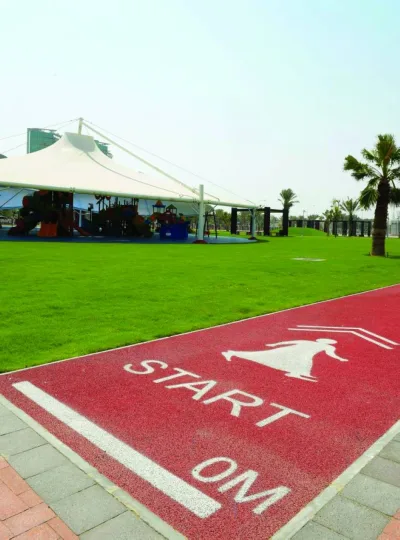On this particular evening, members of 20 Nepali organisations working in Qatar
got together for meetings and get-togethers. By Usha Wagle Gautam
Qatar is home to a variety of Nepali expats. I start each day engaging with this hardworking and humble community, attending their programmes and taking pictures.
I feel a sense of belonging interacting and mingling with them and miss less of Nepal. Recently, while walking to Al Rayyan after attending a programme at the East West Restaurant in Najma, I saw a large group of Nepali folk scattered around in Muntaza Park.
I paused, grabbed a cup of tea from Taxi Hotel, and turned my camera to the colourful shirts inhabiting the park.
To them, such get-togethers have become a part of life. I decided to make way towards the park to talk to them. I took out my pen and notepad and approached a cheerful cluster.
Yub Raj Pandey, who was carrying a dossier, said to me that he and his friends were holding a customary meeting of Arghakhachi Service Society, one of many Nepali groups in Qatar. He said they were discussing the various problems that were being faced by Nepalis coming to Qatar from Arghakhachi, a western hilly district of Nepal. On this particular evening, they were discussing ways they could raise funds to buy an ambulance that could service the hinterlands in Arghakhachi. He said, “This meeting is also about our next programme on raising awareness about traffic rules in Qatar; [but of course issues plaguing] our home district fill our hearts.”
Looking around, I saw another group of people wearing t-shirts printed with the name “Nuwakot Service Society.” These people had gotten together for Dashain and Tihar, two of the biggest festivals in Nepal. Pradip Bohara, one of the group members, said that the society works to improve health and education services in Nuwakot — their home district, which is close to Kathmandu.
The Nepali community in Qatar has become more open with time. Qatar has helped many Nepali youth by providing them with work and in turn enabling them to help their families and communities back home. These youth have come a long way, from struggling to support themselves to working to help their communities back home. In this park on that particular day, I spotted members of Adarsha Service Society, Khas Kshetry Society and Gulmi Service Society, among others.
There are about 100 Nepali organisations active in Qatar, and about 20 of those had members in the park that day.
At the northern corner of the park, a group was distributing lottery prizes to kids, as their smiling parents stood beside them.
It was already 6pm. I joined the group of Tharu Welfare Council and started chatting with Satya Narayan Chaudhary. Chaudhary has been working as a driver in Qatar for eight years. He is an active member of the council, an organisation that represents Tharus, an ethnic Nepali community, in Qatar. The council promotes folk arts and culture of the Tharu community in Qatar.
He said, “We want to create a common forum to discuss elements that have shaped our cultural history. We have also gathered to celebrate Dashain and Tihar. It’s sort of a picnic as we brought food from our homes.”
I then met Raju Bhattarai and Deepak Lamichhane of Morang-Sunsari Service Society and Gorkha Service Society. Same as Chaudhary, they told me they had gotten together to attend the regular meetings of their respective organisations.
My attention was drawn to a group of people wearing t-shirts sporting the words “Nepal Nonresident Magar Association.” The group had a larger number of women in it. Lilam Chidhi Magar, treasurer of the association, said that they were holding the meeting to review the Eid al-Adha celebrations that had been organised by the Ministry of Interior recently. They were discussing the performances that the group members had displayed during the Eid gathering. The group expects to put up even better performances during the upcoming festival of Makar Sankranti.
Bill Gurung, who represents the Tamu Service Society, waved at me, inviting me over for a cup of tea. I joined the group, who are as active in sports and cultural activities as they are in social service. The group decided to hold a language orientation session on November 24, the society’s yearly general assembly on December 12 and Tamu Losha (New Year) on June 2, 2015.
I then ran into Khadananda Banskota, wearing the national dress of Nepal. He too was here for a meeting. His words were touching: “We have lived here with unity and co-operation. I think our leaders in Nepal should learn from us. I am from the eastern part of the country and have a close friend from the western part. Qatar brought us together and we have learnt what friendship and harmony means. We found here the true value of nationalism.”
The artists from the International Nepalese Artists Society (INAS) had also gathered together for a meeting. The society has conducted several international programmes showcasing Nepali culture and arts.
Mahendra Prashad Pokhrel, president of the society, said to me, “When we work, we want to reflect our country and culture. We promote our culture while respecting others. Sharing culture through various modes is essential to understand each other and strengthen the intercultural ties.”
The sky was getting dark, cue for many people to leave. I too wanted to move ahead to Al Rayyan to my home. As I walked, Pokhrel of the INAS accompanied me, telling me about the agenda of their meeting and the role art plays in bringing Nepal and Qatar closer together.
It was then that I realised culture as being an incredible creation of mankind. Even if we are far away from home, our art and culture cannot be forgotten. They rejuvenate us.



